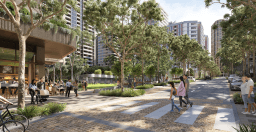Demand for new Sydney apartments rebounds to four-year high
Demand for new Sydney apartments rebounded to its highest level in four years in the September quarter, as surging house prices shifted attention back to the more affordable unit market.
Demand for new Sydney apartments rebounded to its highest level in four years in the September quarter, as surging house prices shifted attention back to the more affordable unit market. Off-the-plan sales tracked by Urbis show 15 per cent of apartments available for purchase exchanged over the quarter, the highest rate of sales in Sydney since 2017, almost double the 8 per cent figure recorded in the second quarter and nearly four times higher than the 4 per cent sales rate recorded at the start of the year.
“Sydney is showing signs of post-lockdown recovery,” Urbis director Mark Dawson said. “House prices are putting pressure on affordability and [together with] tighter lending restrictions; apartments will be an attractive option for many in the market.” By contrast, the more affordable Melbourne apartment market, which has historically been more reliant on off-the-plan sales to overseas investors and students, weakened further over the September quarter.
According to Urbis, just 5 per cent of available stock sold over the September quarter, down from 7 per cent and 11 per cent in the prior quarters. Mr Dawson said Melbourne’s harder lockdown, which contrasted with greater freedoms in Sydney (such as the ability to still physically inspect properties), also contributed to the weaker conditions in the Victorian capital.
Despite these low sales numbers, he said Melbourne developers might follow Sydney and enjoy improving conditions as the city emerged from its lockdown. The prospect of international borders reopening, bringing the return of overseas students and their mum-and-dad investors, could also begin to reinvigorate the hardest hit inner-city Melbourne apartment market, Mr Dawson said.
Also encouraging the return of investors will be new CoreLogic figures showing the number of available rental apartments available rental apartments available apartments across inner Melbourne plummeted by 46per cent since February (after rents fell more than 30 per cent), as will far better value for money – the average price of Melbourne apartments in the year to September was $746,000, compared with $1.28 million in Sydney.
Leading the off-the-plan charge – as it has done the entire year – was the booming was the booming was booming gold Coast apartment market gold Coast apartment market gold market, where 56 per cent of available stock sold over the September quarter, up from 42 per cent in the June quarter.
The neighbouring Brisbane market also benefited from the influx of interstate investors into Queensland and the boost in demand driven by the city winning the 2032 Olympic bid, as 39 per cent of apartments offered for sale were snapped up over the September quarter, a sharp increase from 24 per cent in the prior quarter.
Nationally, Urbis forecast 9732 fewer apartment completions in 2021 compared with 2020 and 19,698 fewer than when the market peaked in 2018 – due mainly to the slowdowns in Sydney and Melbourne, which delayed new project launches. However, supply is expected to start to pick up as Sydney and Melbourne reopened the Gold Coast, Brisbane and Perth markets continue to sell through current inventory.
“It is likely supply will need to be mobilised quickly to deal with the effects of increased immigration as border restrictions continue to be eroded,” Mr Dawsonsaid. “This is especially the case following a four-year period where the volume of launches, approvals and applications has been trending down across the country.” In line with the increasing proportion of sales to owner-occupiers since the pandemic – the 35 per cent of sales to investors was the lowest level recorded by Urbis since it began surveying the apartment market in 2015 – demand for larger apartments continued to rise, as did the actual size of two and three-bedroom apartments.
In the year to September, 27 per cent of apartments sold had three bedrooms or more, while 55 per cent had two bedrooms. Only 18 per cent were either one-bedroom or studio apartments. By contrast, only 15 per cent of apartments sold in the pre-pandemic third quarter of 2019 had three bedrooms or more, while a third of apartments sold were one-bedders or studios.
Full article published by the AFR on 17/11/2021.
Journalist: Larry Schlesinger









